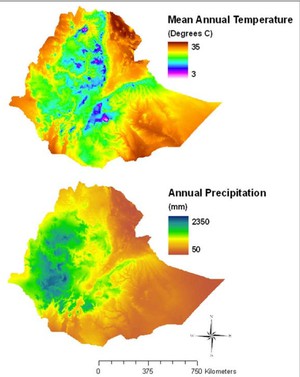The wide variation in elevation (the height of land above sea level) in Ethiopia produces three types of climate, illustrated in Figure 9.9:

Figure 9.9 Maps of the average annual temperature and rainfall across Ethiopia. (Hopping and Wann, 2009)
Based on Figure 9.9, what type of climate and how much rain would you expect in the lowlands of Ethiopia like Asayat, Afar Region?
You would expect a very hot climate and very little rainfall.
If you lived in the highlands, for example in the Simien Mountains, what type of climate would you have and how much rain would you expect?
You would expect a very cold climate and high rainfall.
Like many other countries in the world, climate change has been observed in Ethiopia. Since 1950 the average minimum temperature has been rising by about 0.37 ºC per decade the average temperature is expected to increase substantially if global greenhouse gas emissions continue at the present rate (MoWR/NMA, 2007). The projected increases in Ethiopia’s average temperature in the future are: 0.9–1.1 ºC by 2030, 1.7–2.1 ºC by 2050 and 2.7–3.4 ºC by 2080.
Ethiopia has experienced both dry and wet years since 1950, but the average annual rainfall has remained more or less constant. However, some regions of the country have experienced more frequent and more widespread floods, whereas other regions have been hit by more frequent and intense droughts. Floods and droughts are categorised as ‘extreme weather events’ and you will learn more about them in Study Session 10. Here are some key points to demonstrate that Ethiopia is experiencing climate change (EM-DAT, n.d.):
Low-income countries like Ethiopia are highly vulnerable to the effects of climate change and extreme weather events. They lack sufficient numbers of people who have been trained in how to respond and they lack the organisational and financial resources to deal with the impacts on environments and communities. Rural areas are particularly vulnerable to loss of agricultural livelihoods, leading to population displacement and food shortages. Ethiopian towns and cities are vulnerable to climate change because they are densely populated (Environmental Protection Authority, 2003). You will learn more about the impacts of climate change in Ethiopia in Study Sessions 10 and 11.